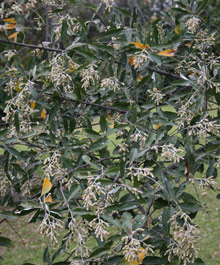Brachylaena transvaalensis
Brachylaena transvaalensis E.Phillips & Schweick.
Family: Asteraceae
Common names: forest silver-oak (Eng.); bosvaalbos, vaalboom (Afr.); umPhahla, iPhahla (Sw, Z); mphahla (NS); mufhata (V)
SA Tree No: 731
Introduction
This medium to large tree with its dark green glossy leaves produces dense clusters of whitish flowers from July to September.

Description
Description
Brachylaena transvaalensis is an evergreen tree, although it can be deciduous at times depending on its location. It can grow to a height of between 10 and 25 metres. This tree produces a single straight trunk which at times is slightly fluted. Although the grey to pale brown bark is smooth initially, it becomes vertically striated and stringy with age. The grey twigs are ribbed and hairless.


The narrowly elliptic leaves are dark green and glossy above and white-felted below. They are alternate with a raised midrib underneath. The leaf margins are either entire or can be shallowly toothed towards the tip of the leavesand are often wavy.
The whitish flowers appear between July and September in dense clusters towards the tips of the branches. The flower stalks are either short or absent.
The fruit appear between September and November; the flower clusters produce clusters of small dry nutlets crowned with tufts of cream bristles.

Conservation Status
Status
None.
Distribution and habitat
Distribution description
Forest silver-oaks are found in different forest types ranging from evergreen and semi-deciduous to riverine. They also occur in wooded grassland along the escarpment. They are distributed throughout KwaZulu-Natal, Mpumalanga and the Limpopo provinces within South Africa and are also found in Swaziland.
Derivation of name and historical aspects
History
Greek brachy: short and chlaina: a cloak, referring to the short floral bracts; transvaalensis: from the Transvaal, former province of South Africa.
Ecology
Ecology
The nectar-rich flowers attract bees and other insects. Young leaves are browsed by bushbuck.
Uses
Use
The strong, hard, fine-grained wood is used for numerous purposes including hut and boat building, fence posts and spear shafts, as well as hoe and axe handles.
Growing Brachylaena transvaalensis
Grow
Propagation takes place either by seed or cuttings.
It grows fast, with a non-invasive root system. It is frost hardy and requires a moderate amount of water as well as full sun.
References
- Joffe, P. 2001. Creative gardening with indigenous plants. A South African guide. Briza Publications. Pretoria.
- Pooley, E. 1993. The complete field guide to trees of Natal, Zululand and Transkei. Natal Flora Publications Trust. Durban.
- Schmidt, E., Lötter, M., McCleland, W. 2002. Trees and shrubs of Mpumalanga and Kruger National Park. Jacana. Johannesburg.
Credits
Lou-Nita Le Roux
Lowveld National Botanical Garden
April 2012
Plant Attributes:
Plant Type: Tree
SA Distribution: KwaZulu-Natal, Limpopo, Mpumalanga
Soil type: Sandy
Flowering season: Spring, Winter
PH: Neutral
Flower colour: White
Aspect: Full Sun
Gardening skill: Average
Special Features:
Horticultural zones









Rate this article
Article well written and informative
Rate this plant
Is this an interesting plant?
Login to add your Comment
Back to topNot registered yet? Click here to register.